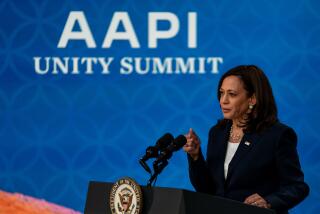GOP, Democrats Woo Different ‘Middle’ Classes
WASHINGTON — Some listened to the lofty rhetoric on car radios during commutes through the suburbs. Some watched the Capitol’s sound and fury from the comfort of easy chairs as dogs and children romped underfoot. Some were working too hard to catch any of the political action.
Like members of the new 104th Congress, which clattered to life last week, members of America’s vast middle class are busy people. And unlike some members of Washington’s political class, they want to see tangible benefits from this Congress, not endless debate.
They are, in short, a class of Americans waiting to be won.
So, to a greater extent than in perhaps any other congressional session in recent memory, lawmakers from both parties are scrambling to satisfy this huge but somewhat hazily defined slice of the nation.
“What’s at stake here is the future of both political parties,” said Sen. John B. Breaux of Louisiana, a moderate Democrat who has sought to push his party toward the center and toward middle-class concerns.
“This is the largest segment of American society, the most politically active and the most frustrated,” Breaux said. “Both parties are trying to convey the message that they are the party that represents the middle class. And this group is still very much up for grabs.”
Lawmakers reached out to them this past week with promises of middle-class tax cuts, with appeals to middle-class values and with bald threats that the other side would sell them out to special interests, either rich or poor.
And they did so even at the risk of alienating some of their most loyal constituencies: for Democrats, those at the bottom rungs of the ladder; for Republicans, the Wall Street financiers who cringe at the inflationary implications of broad tax cuts.
By Friday, the early returns were trickling in, and they showed the GOP slightly ahead in the contest. According to a random poll released Friday by the Washington Post and ABC News, 49% of those surveyed said they trusted the Republicans more than the Democrats to help the middle class. Forty-one percent named the Democrats as the better party to help those Americans.
But from the broad strokes of lawmakers’ speeches to the fine print of their proposals, it became clear last week that there are profound differences in the way the two parties define the middle class. It was equally clear that Republicans and Democrats were pursuing very different strategies in courting those voters.
The House Republican “contract with America,” for instance, would offer a $500 per-child tax credit for families with annual incomes up to $200,000. In the Senate, Republican Phil Gramm of Texas has proposed to double the current $2,500 per-child tax exemption for all families, regardless of income level. Such personal exemptions now start to phase out at $125,000.
“The view of the Democrats on tax cuts is very different than the view of the Republicans,” House Minority Leader Richard A. Gephardt (D-Mo.) told reporters last week. “We want all of the tax cut--whatever it is--to go to middle-income families, that is, families earning $70,000-$75,000 and below.”
Because Republicans on Capitol Hill have proposed economic policies that would benefit decidedly upper-income as well as middle-income families, GOP lawmakers have sought to blur distinctions between middle- and upper-class, collapsing both into a mega-middle class defined more by attitude and work ethic than by income.
“We Republicans are fairly ecumenical in this regard: We’d like to see everybody’s income grow,” Majority Leader Dick Armey (R-Tex.) told reporters Friday. “We’d like to see income mobility. . . . I would like to see everybody’s income go up, even the rich people.”
Gramm last week defined the middle class simply as the overtaxed. “I’m not going to pit one group against each other. Everybody’s overtaxed.” For Republicans, middle class has become “a wonderfully inclusive term” Gramm said in an interview with The Times.
House Speaker Newt Gingrich (R-Ga.) has defined the middle class as “that group of Americans who work for a living, who want to save, who believe that they want their children to have a better future, who are prepared to postpone immediate gratification to try to give their kids a better future, who believe in studying and doing their homework.”
Independent pollster Ed Sarpolus said Republicans appear to be betting that middle-income Americans resent the poor and the aid they have received over the years much more than they resent the rich, for whom they feel admiration and only mild envy. It is a bet that has some solid odds of payoff, added Sarpolus, who has conducted numerous polls and focus groups of the middle class and of baby boomers throughout the Midwest.
The Democrats, analysts said, are taking a different route, choosing a policy of exclusion in their approach to the middle class.
In their rhetoric as well as their slate of economic proposals, Capitol Hill Democrats made clear last week that they hope to win the loyalty of a group of Americans defined more by its middle income than by its mind-set.
With the federal budget deficit ballooning and their options limited, Democratic congressional leaders argued that they must focus their economic proposals on middle-income Americans alone. And they are counting on those middle-income Americans to have a powerful conviction that they, more than the rich, deserve to be the focus of the government’s limited efforts to help.
“I think it’s going to turn this debate now on who can we help, given our resources,” said Rep. Vic Fazio (D-West Sacramento), chairman of the Democratic Caucus, after a meeting Thursday with President Clinton. “And I think when you start looking at priorities, we win.”
But Republicans charged last week that Democrats were engaging in the politics of class warfare.
“The Democrats have played class warfare off and on for 30 years, and they’d like to turn this into a debate that is class warfare too,” Gramm told The Times. But, he added, “class warfare has never worked over the long haul. In periods of economic retrenchment, it’s a winner in the short term. But overall, it’s a loser because Americans don’t see themselves as oppressed people.”
“The Democrats in my estimation . . . seem to be so obsessive with disliking the rich that they don’t have much time left for loving somebody,” Armey groused over breakfast with reporters on Friday.
That charge drew a sharp counterattack from Democrats.
“This is not class warfare,” Gephardt said. “If there is class warfare, (the Republicans) started it 15 years ago by giving huge tax cuts to the wealthiest people in the country, who frankly didn’t need it, and then not doing anything for people in the middle-income group.”
Who will win the battle? Sam Popkin, a political science professor at UC San Diego and deputy pollster for the 1992 Clinton/Gore campaign, had a warning Friday for Capitol Hill Democrats.
“Most Americans would in the end rather identify with the rich than with the poor,” said Popkin, who cautioned that a strategy of seeking to stir resentment among middle-income families against upper-income families is “a battle that Democrats can’t win.”
“This is a losing, rear-guard action by a party in disarray,” Popkin said. “A more winnable strategy would argue that Republican proposals are breaking the bank account. The Democrats would be better off standing up for responsibility, which is not now a very prominent part of their message.”
As they head into another campaign season, however, both sides can claim evidence that their message will resonate with voters.
In the Democrats’ favor are polls suggesting that Americans do draw sharp lines between middle and upper class. In a 1993 survey conducted by CBS News and the New York Times, roughly half of those responding said they believed that those earning between $100,000 and $200,000 per year were no longer middle class.
In the Republicans’ favor, however, is a May, 1994, poll in which 93% of Americans identified themselves as middle class. That would suggest the Republicans’ inclusive definition, in which self-discipline and work ethic appear to count as much as income, will resonate well with potential voters.
As Gingrich said recently, middle class is “a state of mind.”
More to Read
Get the L.A. Times Politics newsletter
Deeply reported insights into legislation, politics and policy from Sacramento, Washington and beyond. In your inbox three times per week.
You may occasionally receive promotional content from the Los Angeles Times.











